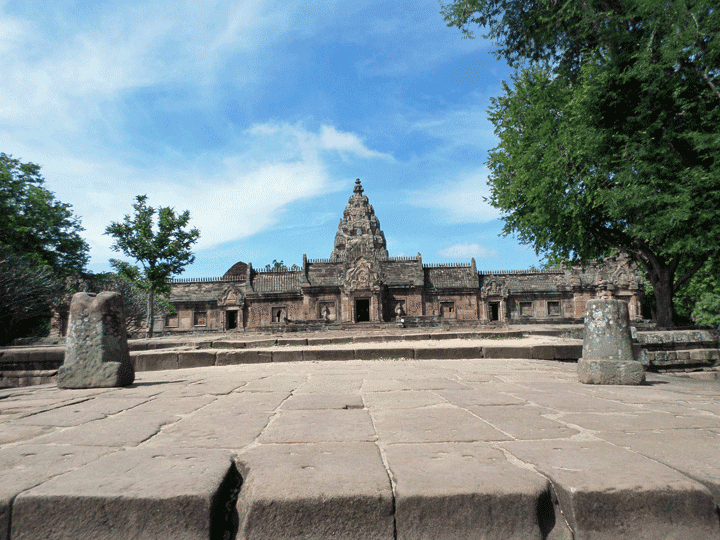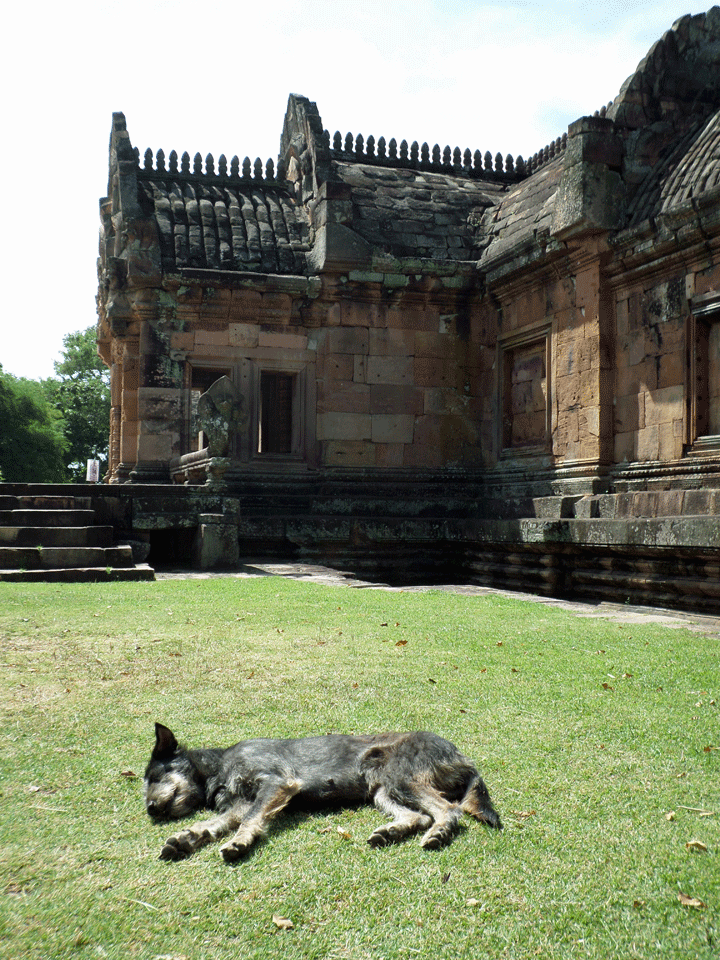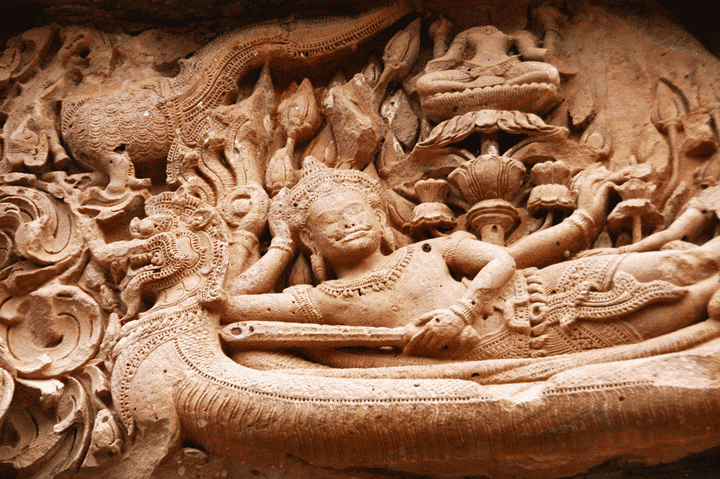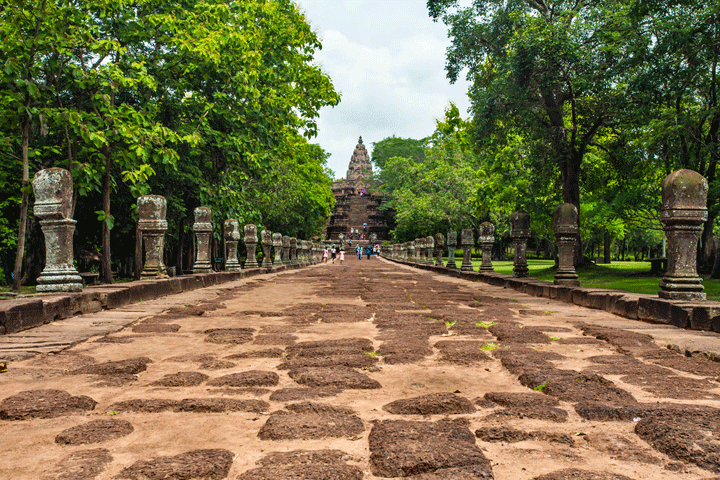
I live in the province Buriram and Prasat Hin Khao Phanom Rung is, so to speak, in my backyard. I have therefore gratefully used this proximity to get to know this site very well, thanks to numerous visits. I would like to take a moment to reflect on this temple, which is one of the most interesting in Thailand in more ways than one.
Not only because it is one of the finest examples of this Khmer architecture but also because he nicely demonstrates how the Thai deal with their heritage and how they use this heritage in their quest for a sense of national identity. A quest in which truth-finding and historicity often have to make way for political correctness and a cultural-historical vision that is acceptable to the established powers.
When you visit this temple, you can't miss it: It stands dramatically on the south side of the summit of the Khao Phanom Rung, an extinct volcano, and dominates the plain around it in a very striking way and that may well be the intention of the builders. This complex was built in different phases between the tenth and thirteenth century from the laterite and sandstone that are common in this region. It was originally a Brahmanistic Hindu temple, dedicated to the god Shiva and symbolized his mythical abode, Mount Kailash in the Himalayas which, as we all know, is the source of the sacred Indus River. The processional path lined with stylized lotus flowers that leads to the central part of the temple therefore represents the spiritual journey that every pilgrim makes from earth to the center of the Hindu cosmos. Cosmos, which is symbolized by the flask-shaped Prang in the middle of the temple.
In Angkor's heyday, this outpost of the once very powerful Khmer Empire was the magnificent center of an imposing religious-educational site. A resting point on the regal route that connected Angkor with the temple of Prasat Hin Phimai, which was expanded with temples (prasat), hospitals (arokayasala), guest houses (dharmasala) and huge water basins (bars).

After the fall of Angkor, unlike many other Khmer buildings, this site was not completely abandoned and therefore did not completely fall prey to the destructive forces of nature. Anthropologists and cultural scientists now assume that both the original local populations, mainly descended from Khmer and Kui, and the Lao and Thai who later settled in the region, continued to regard this place as an important religious center where, after the integration of Theravada Buddhism apparently also had room for the locally strong animism and the ancestor cult. Traces of this local veneration can be traced back to the extensive restoration and renovation of this complex from the XNUMXs. For example, pilgrims from the provinces of Buriram and Surin, annually in procession in April, came on foot to the temple for phrapheni duean ha sip kham, a religious festival where people prayed for rain and protection from thieves and other unsavory elements. It is certain that for centuries in the immediate vicinity of Phanom Rung, ghosts (chao prasat) were honored at a Bodhi tree. Incidentally, the Muang Tam temple at the foot of Phanom Rung was also involved in these ceremonies. After all, the local population firmly believed that the guardian spirit (pho pu of tapu) of Phanom Rung, here lived…
In the last half of the nineteenth century, Siam was looking for its own identity. The state was still in full expansion, but its territorial integrity was threatened by the colonial aspirations of the Western powers. The implementation of a sense of identity served to stimulate a sense of national belonging and national pride in the multi-ethnic state that Siam was. After all, the country was a patchwork of regional political-administrative entities (muangs) which were tied together in a precarious balance by alliances and came only with difficulty under a single central authority.
One of the first Siamese notables to realize that history is a determining factor in the experience of identity was Prince Damrong Ratchanuphap (1862-1943). This half-brother of King Chulalongkorn not only played a key role in the reform and modernization of the Siamese education system, health care and administration, but was also a 'selfmade historian'that if'Father of Thai Historiography' has had a huge influence on the development of a national consciousness and the way Siamese/Thai history was and is being told. In his writings he managed to replace the pre-modern historicizing stories and traditions, which were in fact an eclectic but historically inaccurate mix of secular and religious stories and myths, with empirical historiography. Historiography, which in turn was instrumental in legitimizing the modernization of the Chakri dynasty in that period and would later become one of the cornerstones of Thai nationalist ideology and the barely definable'Thainess'feeling that still prevails in certain sections of Thai society to this day.
Prince Damrong visited the complex in 1929 during a trip through Isaan, where he, accompanied by a few archaeologists and art historians, mainly tried to map the relics of the Khmer Empire. It was a period in which especially the French on the eastern border of Siam, near Angkor, tried to do exactly the same with large-scale archaeological projects and Damrong did not want to be left behind. He wanted to prove with his own expedition that Siam, like all other civilized nations, could deal with its heritage in a scientifically sound way. The historian Byrne described Damrongs' archaeological expeditions in 2009 as "means of collecting local source material to build national history' and he was, in my humble opinion, quite right. Damrong realized like few others that heritage and monuments could play a capital role in stimulating the collective memory of the gradually taking shape Siamese nation. He considered Phanom Rung a unique site, the biography of the nation turned to stone. That is why Damrong was not only the first to initiate the conservation and – in the future – restoration of this site, but also advocated the upgrading of Prasat Hin Khao Phanom Rung from a local shrine to a national monument. There was of course also a -hidden- geopolitical side to upgrading this temple complex because Damrong also tried to show that the glorious Khmer past - of course mainly claimed by the Cambodians - was just as much an inseparable part of Siamese history….

A controversial line of thought, to say the least, and certainly in Cambodia, which was rejected in Pnomh Pen as a distasteful attempt at historical revisionism. The dispute over the nearby Prasat Preah Vihear temple shows to this day how sensitive this matter is. When the International Court of Justice decided in favor of Cambodia in the case of Prasat Preah Vihear in 1962, public opinion in Thailand reacted with horror and disbelief and turbulent mass demonstrations ensued. Only a year later, in January 1963, partly under international pressure, Thailand withdrew its troops from this temple complex, but the following decades and until now this conflict has continued to smolder, with the tragic low point being the border conflict that flared up in 2011 and left several dozen dead and injured. yielded.
But back to Prasat Hin Khao Phanom Rung. In 1935, six years after Damrongs' visit, the temple complex was closed by a decree passed in the Government Gazette (no. 52- chapter 75) was published, protected as a national monument. Yet it would take almost thirty years before serious work was done on the restoration and integration into the planned Historical Park. After the necessary preparatory studies and work in the 1971s, during which the Thai government could count on the expertise of BP Groslier and P. Pichard, two French UNESCO experts, the actual restoration began in XNUMX. Phimai was also tackled in the same period. As a former heritage worker, I can only be grateful that in Phanom Rung, unlike Phimai, a 'soft' restoration was chosen, which only enhanced the authenticity.

It is notable that a number of archaeological studies were published in the period of the Restoration in which Thai academics such as Manit Wailliphodom (1961), MC Subhadradis Diskul (1973) and Princess Maha Chakri Sirindhorn (1978), elaborating on earlier, mainly French Khmer studies , gave a distinctly nationalist-inspired interpretation of the archaeological finds at this site that firmly anchored the temple complex in Thailand's national historical canon. The reopening of the site in 1988 was accompanied by another event that was blown to national proportions, namely the return of the Phra Narai capstone dating from the early XNUMXs. Temple was stolen and later mysteriously found in it Art Institute had surfaced in Chicago. Thai public opinion demanded a return and even the immensely popular rock band in Isaan Carabao was called in to recover this precious piece of heritage. This campaign can be seen as a turning point. Large parts of the Thai population had become aware of the importance of Phanom Rung and of the special place that the heritage of Khmer culture has occupied in the national memory.
After the reopening of the Heritage park in 1988 the annual pilgrimage was transformed into a cultural spectacle. A three-day show that has clearly broken with the local-religious character and is mainly aimed at attracting and enchanting tourists. It is not for nothing that this is heavily promoted by the provincial government and the tourist office of Buriram, who try to convince the gullible visitors that this rather kitschy spectacle goes back to a thousand-year tradition. Prasat Hin Khao Phanom Rung has today become an example of what the historian and Thailand expert Maurizio Peleggi 'The politics of ruins and the business of nostalgia' calls. And I honestly don't know if I should be happy about that...


Excellent story, Lung Jan, which I enjoyed reading. You draw a beautiful and correct line between past and present. The nationalistic historiography, khwaampenthai, Thainess, Thai identity are not so much true as intended to support the people's sense of unity. However, the result is questionable. Many people feel more Lao, Thai Lue, Khmer, Malay etc. than Thai.
I really have nothing to add except something about the name Prasat Hin Khao Phanom Rung
in Thai letters ปราสาทหินพนมรุ้ง where, however, the word เขา khao 'hill, mountain' is missing.
Prasat (pronounced praasaat tones middle, low) means 'palace, temple, castle', hin (tone rising) means 'stone' as in Hua Hin, phanom (two middle tones) is a real Khmer word and means 'mountain, hill' as in Nakhorn Phanom and Phnom Pen; rung (roeng, high-pitched) is 'rainbow'. 'The Stone Temple on Rainbow Mountain', something like that. Khao and Phanom is a bit of a double, both is 'mountain, hill'. .
Here is a link to a beautiful interactive map of this complex. Walk it on your cell phone.
http://virtualhistoricalpark.finearts.go.th/phanomrung/360/phanomrung.html
Indeed a beautiful interactive map with many opportunities to view details. Thank you!
Nice story, nice temple (I've been there once). Damrong has bended history to Bangkok's hand and had no qualms about rewriting history in a way that suited Siam (read Bangkok) best. Everything for Thainess.
“alliances and only with difficulty came under one central authority.” That's a nice understatement for the internal colonization of what is now Thailand.
See also: https://www.thailandblog.nl/achtergrond/isaaners-zijn-geen-thai-wie-mag-zich-thai-noemen-het-uitwissen-van-de-plaatselijke-identiteit/
What a beautiful temple. I also found Anggor very impressive. But this is also worth a visit.
Very informative story about this beautiful temple complex. Located on a high hill in the flat landscape, this Khmer temple is well worth a visit. Because of my visit to a Thai family who lives near Prakhon Chai, I have visited this temple several times in recent years.
On my last visit, some ten years ago, I found a Hindu linga, a marble phallus, in the complex. I had already seen some in the temple complex in Mammalapuram in the Indian state of Tamil Nadu. My Thai supervisor had no idea what the image represented…
Lung Jan thanks for your background information. We finally went there in February, when there were hardly any visitors, so that I could view and photograph everything at my leisure. Visited Muang Tam the first day in the afternoon and Phanom Rung the next day I was definitely impressed, the complex was bigger than I expected. Naturally, it evokes memories of Angkor Wat.
For anyone who ever wants to go here, don't forget to visit Muang Tam too!
The annual festival is in the first week of April. Locals flock up the hill for the Climbing Khao Phanom Rung Festival: a scene of traditional dance and light shows.